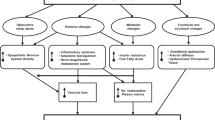Abstract
Resistant hypertension is currently defined as the failure to achieve a goal blood pressure <140/90 mmHg in patients who are compliant with maximal tolerated doses of a minimum of three antihypertensive drugs, one of which must be a diuretic. The increasing prevalence of obesity and hypertension in the general population mean that this disorder has gained attention in the past decade. In the past 2 years, large-scale population-based studies such as the US National Health and Nutrition Examination Survey (NHANES) have specifically examined the prevalence and incidence of resistant hypertension, and associated risk factors. The findings suggest the prevalence of resistant hypertension is 8–12% of adult patients with hypertension (6–9 million people). The increasing prevalence of resistant hypertension contrasts with the improvement in blood pressure control rates during the same period. Studies also show that patients with resistant hypertension aged >55 years, of black ethnicity, with high BMI, diabetes or chronic kidney disease have an increased risk of cardiovascular events compared to nonresistant hypertensive patients. Analyses that exclude the effects of white-coat hypertension and pseudoresistant hypertension are also needed to clarify the epidemiology of true resistant hypertension.
Key Points
-
Best estimates of the prevalence of resistant hypertension suggest it affects 9–12% of the 72 million people with hypertension in the US
-
Resistant hypertension occurs predominantly in men, those aged >55 years, and in individuals who are black, have diabetes mellitus, are obese or have stage 3 or higher chronic kidney disease
-
Ambulatory blood pressure monitoring and assessment of adherence to medication is essential to eliminate pseudoresistant hypertension as a diagnosis
This is a preview of subscription content, access via your institution
Access options
Subscribe to this journal
Receive 12 print issues and online access
$209.00 per year
only $17.42 per issue
Buy this article
- Purchase on Springer Link
- Instant access to full article PDF
Prices may be subject to local taxes which are calculated during checkout
Similar content being viewed by others
Change history
09 July 2013
In the print and online pdf versions of this article, the doi was incorrectly given as “10.1038/nrgastro.2012.260” instead of “10.1038/nrneph.2012.260”. The error has been corrected online.
References
Wolf-Maier, K. et al. Hypertension prevalence and blood pressure levels in 6 European countries, Canada, and the United States. JAMA 289, 2363–2369 (2003).
Ong, K. L., Cheung, B. M., Man, Y. B., Lau, C. P. & Lam, K. S. Prevalence, awareness, treatment, and control of hypertension among United States adults 1999–2004. Hypertension 49, 69–75 (2007).
Chobanian, A. V. et al. Seventh report of the Joint National Committee on Prevention, Detection, Evaluation, and Treatment of High Blood Pressure. Hypertension 42, 1206–1252 (2003).
Mancia, G. et al. ESH-ESC Practice guidelines for the management of arterial hypertension: ESH-ESC Task Force on the Management of Arterial Hypertension. J. Hypertens. 25, 1751–1762 (2007).
Lewington, S., Clarke, R., Qizilbash, N., Peto, R. & Collins, R. Age-specific relevance of usual blood pressure to vascular mortality: a meta-analysis of individual data for one million adults in 61 prospective studies. Lancet 360, 1903–1913 (2002).
K/DOQI clinical practice guidelines on hypertension and antihypertensive agents in chronic kidney disease. Am. J. Kidney Dis. 43, 1–290 (2004).
Fox, C. S. et al. Predictors of new-onset kidney disease in a community-based population. JAMA 291, 844–850 (2004).
Perkovic, V., Huxley, R., Wu, Y., Prabhakaran, D. & MacMahon, S. The burden of blood pressure-related disease: a neglected priority for global health. Hypertension 50, 991–997 (2007).
Wolf-Maier, K. et al. Hypertension treatment and control in five European countries, Canada, and the United States. Hypertension 43, 10–17 (2004).
Sarafidis, P. A. & Bakris, G. L. Resistant hypertension: an overview of evaluation and treatment. J. Am. Coll. Cardiol. 52, 1749–1757 (2008).
Roger, V. L. et al. Heart disease and stroke statistics--2011 update: a report from the American Heart Association. Circulation 123, e18–e209 (2011).
Egan, B. M., Zhao, Y. & Axon, R. N. US trends in prevalence, awareness, treatment, and control of hypertension, 1988–2008. JAMA 303, 2043–2050 (2010).
Roger, V. L. et al. Heart disease and stroke statistics--2012 update: a report from the American Heart Association. Circulation 125, e2–e220 (2012).
Sarafidis, P. A. Epidemiology of resistant hypertension. J. Clin. Hypertens. (Greenwich) 13, 523–528 (2011).
Roberie, D. R. & Elliott, W. J. What is the prevalence of resistant hypertension in the United States? Curr. Opin. Cardiol. 27, 386–391 (2012).
Calhoun, D. A. et al. Resistant hypertension: diagnosis, evaluation, and treatment. A scientific statement from the American Heart Association Professional Education Committee of the Council for High Blood Pressure Research. Hypertension 51, 1403–1419 (2008).
Moser, M. & Setaro, J. F. Clinical practice. Resistant or difficult-to-control hypertension. N. Engl. J. Med. 355, 385–392 (2006).
Pimenta, E., Gaddam, K. K. & Oparil, S. Mechanisms and treatment of resistant hypertension. J. Clin. Hypertens. (Greenwich) 10, 239–244 (2008).
Yakovlevitch, M. & Black, H. R. Resistant hypertension in a tertiary care clinic. Arch. Intern. Med. 151, 1786–1792 (1991).
Garg, J. P. et al. Resistant hypertension revisited: a comparison of two university-based cohorts. Am. J. Hypertens. 18, 619–626 (2005).
Acelajado, M. C. et al. Refractory hypertension: definition, prevalence, and patient characteristics. J. Clin. Hypertens. (Greenwich) 14, 7–12 (2012).
De Nicola, L. et al. Burden of resistant hypertension in hypertensive patients with non-dialysis chronic kidney disease. Kidney Blood Press. Res. 34, 58–67 (2011).
Hajjar, I. & Kotchen, T. A. Trends in prevalence, awareness, treatment, and control of hypertension in the United States, 1988–2000. JAMA 290, 199–206 (2003).
Egan, B. M., Zhao, Y., Axon, R. N., Brzezinski, W. A. & Ferdinand, K. C. Uncontrolled and apparent treatment resistant hypertension in the United States, 1988 to 2008. Circulation 124, 1046–1058 (2011).
Saydah, S. H., Fradkin, J. & Cowie, C. C. Poor control of risk factors for vascular disease among adults with previously diagnosed diabetes. JAMA 291, 335–342 (2004).
Sarafidis, P. A. et al. Hypertension awareness, treatment, and control in chronic kidney disease. Am. J. Med. 121, 332–340 (2008).
Lloyd-Jones, D. M. et al. Differential control of systolic and diastolic blood pressure: factors associated with lack of blood pressure control in the community. Hypertension 36, 594–599 (2000).
Sarafidis, P. A. & Bakris, G. L. State of hypertension management in the United States: confluence of risk factors and the prevalence of resistant hypertension. J. Clin. Hypertens. (Greenwich) 10, 130–139 (2008).
ALLHAT Officers and Coordinators for the ALLHAT Collaborative Research Group. The Antihypertensive and Lipid-Lowering Treatment to Prevent Heart Attack Trial. Major outcomes in high-risk hypertensive patients randomized to angiotensin-converting enzyme inhibitor or calcium channel blocker vs diuretic: The Antihypertensive and Lipid-Lowering Treatment to Prevent Heart Attack Trial (ALLHAT). JAMA 288, 2981–2997 (2002).
Dahlof, B. et al. Cardiovascular morbidity and mortality in the Losartan Intervention For. Endpoint reduction in hypertension study (LIFE): a randomised trial against atenolol. Lancet 359, 995–1003 (2002).
Pepine, C. J. et al. A calcium antagonist vs a non-calcium antagonist hypertension treatment strategy for patients with coronary artery disease. The International Verapamil-Trandolapril Study (INVEST): a randomized controlled trial. JAMA 290, 2805–2816 (2003).
Jamerson, K. et al. Benazepril plus amlodipine or hydrochlorothiazide for hypertension in high-risk patients. N. Engl. J. Med. 359, 2417–2428 (2008).
dam-Marx, C., Ye, X., Sung, J. C., Brixner, D. I. & Kahler, K. H. Results of a retrospective, observational pilot study using electronic medical records to assess the prevalence and characteristics of patients with resistant hypertension in an ambulatory care setting. Clin. Ther. 31, 1116–1123 (2009).
Persell, S. D. Prevalence of resistant hypertension in the United States, 2003–2008. Hypertension 57, 1076–1080 (2011).
Kaplan, N. M. Resistant hypertension. J. Hypertens. 23, 1441–1444 (2005).
Daugherty, S. L. et al. Incidence and prognosis of resistant hypertension in hypertensive patients. Circulation 125, 1635–1642 (2012).
Gupta, A. K. et al. Baseline predictors of resistant hypertension in the Anglo-Scandinavian Cardiac Outcome Trial (ASCOT): a risk score to identify those at high-risk. J. Hypertens. 29, 2004–2013 (2011).
Brown, M. A., Buddle, M. L. & Martin, A. Is resistant hypertension really resistant? Am. J. Hypertens. 14, 1263–1269 (2001).
de la Sierra, A. et al. Clinical features of 8295 patients with resistant hypertension classified on the basis of ambulatory blood pressure monitoring. Hypertension 57, 898–902 (2011).
Klag, M. J. et al. Blood pressure and end-stage renal disease in men. N. Engl. J. Med. 334, 13–18 (1996).
Cuspidi, C. et al. High prevalence of cardiac and extracardiac target organ damage in refractory hypertension. J. Hypertens. 19, 2063–2070 (2001).
de la Sierra, A. et al. Clinical differences between resistant hypertensives and patients treated and controlled with three or less drugs. J. Hypertens. 30, 1211–1216 (2012).
Salles, G. F., Cardoso, C. R. & Muxfeldt, E. S. Prognostic influence of office and ambulatory blood pressures in resistant hypertension. Arch. Intern. Med. 168, 2340–2346 (2008).
Muxfeldt, E. S., Cardoso, C. R. & Salles, G. F. Prognostic value of nocturnal blood pressure reduction in resistant hypertension. Arch. Intern. Med. 169, 874–880 (2009).
Muxfeldt, E. S., Cardoso, C. R., Dias, V. B., Nascimento, A. C. & Salles, G. F. Prognostic impact of the ambulatory arterial stiffness index in resistant hypertension. J. Hypertens. 28, 1547–1553 (2010).
Collins, R. et al. Blood pressure, stroke, and coronary heart disease. Part 2, Short-term reductions in blood pressure: overview of randomised drug trials in their epidemiological context. Lancet 335, 827–838 (1990).
Kandzari, D. E. et al. Catheter-based renal denervation for resistant hypertension: rationale and design of the SYMPLICITY HTN-3 Trial. Clin. Cardiol. 35, 528–535 (2012).
Author information
Authors and Affiliations
Contributions
P. A. Sarafidis and G. L. Bakris contributed equally to discussion of content for the article, researching data to include in the manuscript, writing, reviewing and editing of the manuscript before submission.
Corresponding author
Ethics declarations
Competing interests
G. L. Bakris has acted as a consultant for Abbott, CVRx, Daichi–Sankyo, Medtronic, Novartis, Relypsa and Takeda, and that he has received grants from Forest Laboratories and Takeda. In addition, G. L. Bakris is joint principal investigator of the Symplicity HTN 3 clinical trial and the principal investigator of AMETHYST-DN clinical trial. P. A. Sarafidis and P. Georgianos declare no competing interests.
Rights and permissions
About this article
Cite this article
Sarafidis, P., Georgianos, P. & Bakris, G. Resistant hypertension—its identification and epidemiology. Nat Rev Nephrol 9, 51–58 (2013). https://doi.org/10.1038/nrneph.2012.260
Published:
Issue Date:
DOI: https://doi.org/10.1038/nrneph.2012.260
This article is cited by
-
A risk prediction nomogram for resistant hypertension in patients with obstructive sleep apnea
Scientific Reports (2024)
-
Application of myocardial work in predicting adverse events among patients with resistant hypertension
Journal of Cardiothoracic Surgery (2023)
-
New Potential Treatments for Resistant Hypertension
Current Cardiology Reports (2023)
-
Application of omics in hypertension and resistant hypertension
Hypertension Research (2022)
-
Current antihypertensive treatment and treatment-resistant hypertension in Japanese patients with chronic kidney disease
Clinical and Experimental Nephrology (2022)



